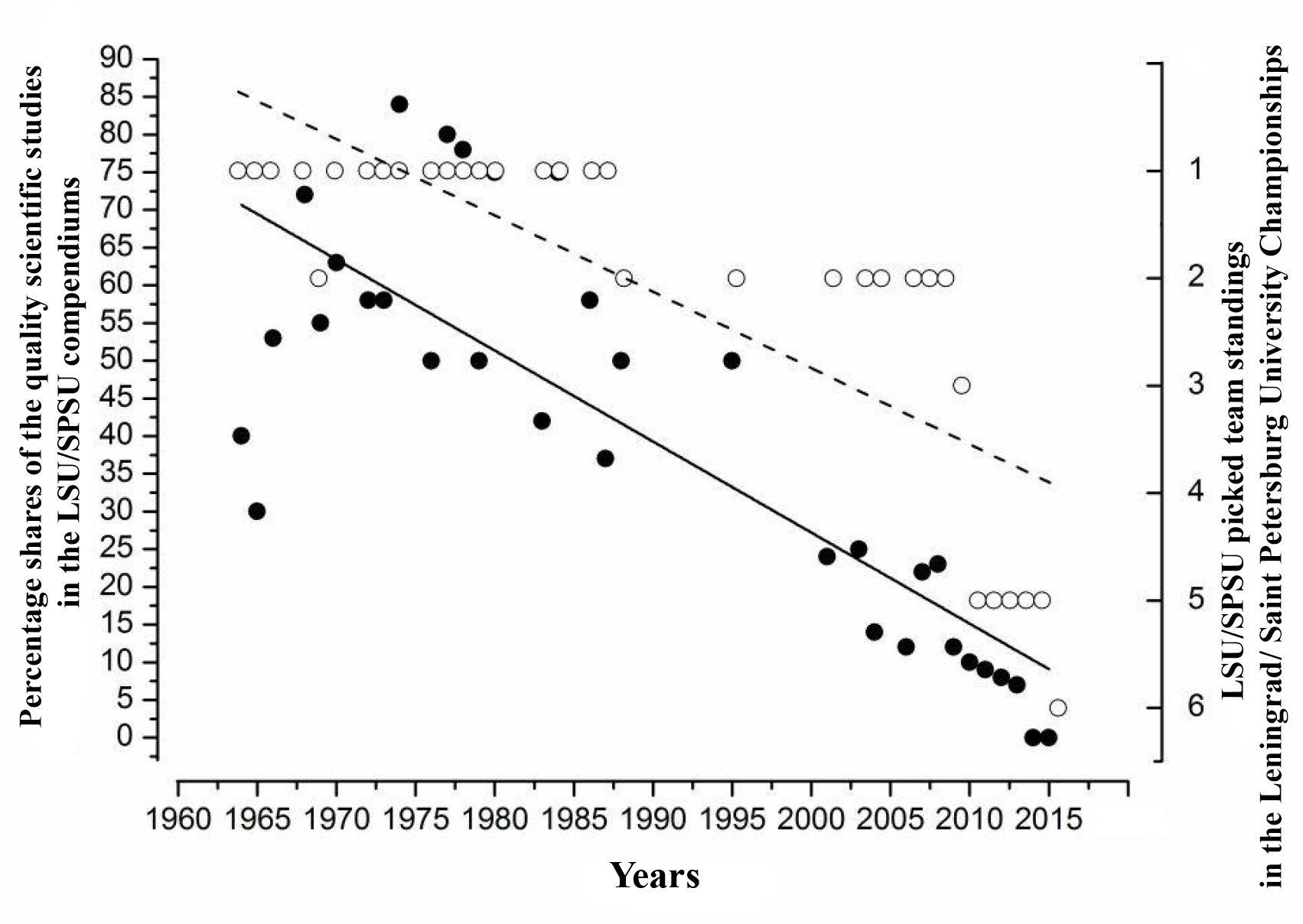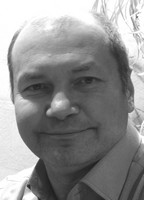Impacts of research quality on academic sport accomplishments at classical university
Фотографии:
ˑ:
PhD, Associate Professor R.S. Minvaleev1
PhD, Professor B.A. Mikhailov1
PhD A.I. Ivanov1
PhD, Associate Professor E.N. Korableva2
St. Petersburg State University, St. Petersburg
Baltic State Technical University “Voyenmeh”, St. Petersburg
Keywords: academic sports, sport science, quasi-science, higher school.
Background. A priority goal of the modern research in the national sports is to secure competitive progress; with the benefits of successful research projects being partially verified by practical competitive accomplishments [4]. Effects of the ongoing research projects on the competitive progress of the national teams may be rated by the growing or sagging competitive success rates. It should be noted that the negative effects may be no less important for the study purposes than the positive effects of the sport science on the athletic progress.
Objective of the study was to rate practical effects of the research projects on the actual competitive accomplishments in the academic sports at a classical university.
Methods and structure of the study. Subject to the study were 35 issues of “Academic Physical Education Matters” dated 1964 to 2010 with the study reports by the Saint Petersburg State University faculty, plus proceedings of the annual Research and Practical Conferences “Physical Education and Sports in the Academic Education System: Innovations and Prospects” for the period of 2011-2015 [1, 3]. The subject publications were classified into the following three categories:
1) General studies without a focus on a specific scientific matter;
2) Educational process studies with concern to the academic Physical Education discipline teaching theory and practices; and
3) Sport-excellence-process related studies in specific sport disciplines with analytical elements and descriptions including probability ratings, biomechanics, mathematical modelling tools etc.
Classified with the last category were the quality scientific works in the subject total (n=535) published in the compendiums under the study; with the mathematical processing of the study/ test data being accepted as the qualification criterion for the quality scientific category [2].
For every issue under analysis, we computed percentage rates of each of the above categories. Furthermore, we mined the accessible data on the LSU/SPSU picked team standings on the team total scoreboards of the Leningrad/ Saint Petersburg University Championships for the period of 1964 to 2015: see the data in Table 1 hereunder.
Table 1
|
1 |
2 |
3 |
4 |
5 |
6 |
|
Year |
Issue of compendium/ conference
|
General PE matters, % |
Academic PE matters, % |
Sport excellence matters, % |
SPSU team standing in University Championships |
|
1964 |
1 |
20 |
40 |
40 |
1 |
|
1965 |
2 |
30 |
40 |
30 |
1 |
|
1966 |
3 |
20 |
27 |
53 |
1 |
|
1968 |
4 |
28 |
- |
72 |
1 |
|
1969 |
5 |
18 |
27 |
55 |
2 |
|
1970 |
6 |
25 |
12 |
63 |
1 |
|
1972 |
7 |
42 |
- |
58 |
1 |
|
1973 |
8 |
17 |
25 |
58 |
1 |
|
1974 |
9 |
16 |
- |
84 |
1 |
|
1976 |
10 |
37 |
13 |
50 |
1 |
|
1977 |
11 |
20 |
- |
80 |
1 |
|
1978 |
12 |
22 |
- |
78 |
1 |
|
1979 |
13 |
17 |
33 |
50 |
1 |
|
1980 |
14 |
25 |
- |
75 |
1 |
|
1983 |
15 |
42 |
16 |
42 |
1 |
|
1984 |
16 |
- |
25 |
75 |
1 |
|
1986 |
17 |
14 |
28 |
58 |
1 |
|
1987 |
18 |
13 |
50 |
37 |
1 |
|
1988 |
19 |
50 |
- |
50 |
2 |
|
2001 |
26 |
30 |
46 |
24 |
2 |
|
2003 |
27 |
42 |
33 |
25 |
2 |
|
2004 |
28 |
60 |
26 |
14 |
2 |
|
2005 |
29 |
85 |
15 |
0 |
2 |
|
2006 |
30 |
75 |
13 |
12 |
2 |
|
2007 |
31 |
55 |
23 |
22 |
2 |
|
2008 |
32 |
77 |
- |
23 |
2 |
|
2009 |
33 |
55 |
33 |
12 |
3 |
|
2010 |
34 |
80 |
10 |
10 |
5 |
|
2011 |
Conference |
52 |
39 |
9 |
5 |
|
2012 |
Conference |
52 |
40 |
8 |
5 |
|
2013 |
Conference |
43 |
50 |
7 |
5 |
|
2014 |
Conference |
50 |
50 |
0 |
5 |
|
2015 |
Conference |
46 |
54 |
0 |
6 |
Study results and discussion. Having applied the least-squares method, we made a linear approximation of the two matrices derived from the Table 1 data arrays (columns 1 and 5; plus columns 1 and 6). For clarity, the SPSU picked team standings in the University Championships are presented in the negative range of the numerical axis. In addition, given on Figure 1 is the combined graphical interpretation of the two linear forms approximating the percentage shares of the sport-excellence-related studies versus the SPSU team standings in the Leningrad/ Saint Petersburg University Championships for the study period.

Figure 1. Combined graphical interpretation of the two linear forms approximating the percentage shares of the quality sport-excellence-related studies versus the SPSU team standings in the Leningrad/ Saint Petersburg University Championships for the period of 1964 to 2015;
─── Linear approximation of the percentage shares of sport-excellence-related studies with time in the LSU/SPSU compendiums;
○ – LSU/SPSU picked team standings in the Leningrad/ Saint Petersburg University Championships for the period of 1964 to 2015;
- - - - Linear approximation of the LSU/SPSU picked team standings in the Leningrad/ Saint Petersburg University Championships for the same period.
To further verify the found regularity we computed the Spearman’s range correlation ratio for the yearly percentage shares of the quality scientific studies in the LSU/SPSU compendiums for the period of 1964 to 2015 versus the LSU/SPSU picked team standings in the Leningrad/ Saint Petersburg University Championships for the same period in the negative expression. The produced Spearman’s range correlation ratio (ρtest) was estimated at 0.846 that is indicative of the percentage share of the quality scientific studies being in direct close correlation with the competitive accomplishments of the LSU/SPSU picked team. The correlation strength/ closeness rate was fairly high on the Chaddock scale. Critical value of the Spearman’s range correlation ratio (ρcritical) was estimated at 0.345 for 31 degrees of freedom. Since the ρtest > ρcritical, we may interpret the correlation of both variables as statistically significant with the probability of type 1 error estimated at p<0.05.
Table 1 and Figure 1 demonstrate the percentage shares of the quality sport-excellence-related scientific studies for the period of 1966 to 1985 coming to the peaking range of 50-80% in excess of all other publications. This is exactly the time period when the competitive accomplishments of the University athletes were the highest as well, with the University team ranked an unchallengeable leader as demonstrated by the team standings in the Leningrad university championships and very successful in the USSR and international competitions. It was in that period that T.V. Kazankina and Y.A. Tarmak became Olympic Champions in the track and field events. However, since 2000ies the competitive accomplishments of the University athletes were on the fall in parallel with the numbers of high-quality scientific publications in the University compendium as demonstrated by our analysis. It may be pertinent to note that the share of general studies (without specific study subject) was found to rise to 50-70% in the same period of 2000 to 2015.
Our findings provide an additional substantiation for the conclusions of the Pseudo-science and Scientific Falsifications Control Commission of the Russian Academy of Sciences that gave a definition of quasi-science as the research process mimicking activity that has no scientific results [2]. We believe that the most harmful effect of the quasi-scientific activity is its expressly negative impact on the subject scientific matter it parasites on. As demonstrated by the present study, growth of the quasi-scientific studies was found to correlate with the falls in the LSU/SPSU team competitive accomplishments in the period of 1964-2015 when the team was trained by the authors of the latter in the University compendium for this period [1, 3].
Conclusion. Falls in the share of high-quality research publications associated with the growths of quasi-scientific publications were found to correlate with the expressed falls in the competitive accomplishments of the University picked team trained by the authors of the latter.
References
- Voprosy fizicheskogo vospitaniya studentov». Sbornik. LGU/SPbGU. I-XXXV [Matters of academic physical education. Collection. Leningrad State University/ St. Petersburg State University]. St. Petersburg: SPbU publ., 1964-2010.
- Galmak AM. Mozhno li izmerit kvazinauku? [Can we measure quasi-science?]. V zaschitu nauki. Byulleten no. 3. Komissiya po borbe s lzhenaukoy i falsifikatsiey nauchnykh issledovaniy RAN [In defense of science. Bulletin no. 3. Commission for Combating Pseudoscience and Falsification of Scientific Research of the Russian Academy of Sciences]. Moscow: Nauka publ., 2008, pp. 70-80.
- Materialy ezhegodnoy nauchno prakticheskoy konferentsii «Fizicheskaya kultura i sport v sisteme vysshego obrazovaniya: innovatsii i perspektivy» [Proc. annual res.-practical conference "Physical Culture and Sport in Higher Education System: Innovations and Perspectives]. St. Petersburg, 2011-2015.
- Radchich I.Y., Kofman L.B., Kurashvili V.A. Tseli i zadachi informatsionno-analiticheskoy deyatelnosti v sfere sportivnoy nauki [Goals and objectives of information and analytical activities in sport science]. Vestnik sportivnoy nauki, 2013, no. 5, pp. 31-35.
Corresponding author: khubbiev@gmail.com
Abstract
Impacts of sport sciences on the academic sport accomplishments were analysed at Saint Petersburg State University. Subject to the study were 35 issues of “Academic Physical Education Matters” dated 1964 to 2010 with the study reports by the Saint Petersburg State University faculty, plus proceedings of the annual Research and Practical Conferences “Physical Education and Sports in the Academic Education System: Innovations and Prospects” for the period of 2011-2015. The authors applied the relevant mathematical (linear approximation by the least-squares method) and statistical (Spearman’s range correlation) tools to obtain the publishing activity profiles of the staff trainers and instructors of the SPSU Physical Education and Sports Department; and the study data showed that the recent sag in the high-quality study reports associated with an inflow of quasi-scientific publications has been of direct negative impact on the Saint Petersburg State University picked team competitive accomplishments when it was trained by the authors of the latter.



